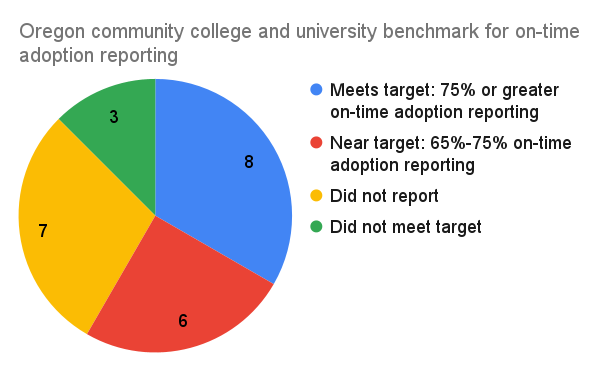Oregon’s legislature passed HB 2919 in 2021. The bill requires that Oregon’s public community colleges and universities prominently display or link to the estimated cost of all required course materials and fees at the time that registration opens for a target of 75% of all courses offered per term. It was informed by a similar policy implemented in Florida.
The purpose of the on-time course materials adoption policy is to provide transparent cost information to students at the point of registration so they can plan their entire budget for the upcoming term. Textbook costs may seem negligible compared to tuition and housing, but the financial emergencies that cause students to drop out may not have especially high price tags. Research from the National Association of Student Personnel Administrators shows that most emergency aid, in the form of campus vouchers, emergency loans, and unrestricted grants, is likely to be for dollar amounts of $100–$500. On average, a full-time student in Oregon can expect to spend this amount on textbooks per term.
This report shows that Oregon’s public community colleges and universities are making progress in communicating costs to students.
Institutional Data Request
In Fall 2020, the OER point person at each institution started receiving information to prepare for the data collection that took place during Spring 2021. The point person either determined that it was possible to report the data themself, or identified institutional partners who could help meet the request.
The data requested aligns with the requirements of the bill:
- % of for-credit courses offered that had estimated course materials costs available when registration opened via the course schedule
- Method of prioritizing which for-credit courses did not provide information
- Schedule of dates by which faculty or departments notify their campus store of course materials adoption
- Method of communicating course materials adoption to the campus store, including policies, communication plan, workflows, etc.
- For courses that do not meet the reporting deadline, why? What can improve reporting for next time?
- Data analysis pain points—what do you plan to improve for the next reporting year?
This report covers Fall 2022, Winter 2023, and Spring 2023. Institutions could decide whether to break out their on-time adoption rate per quarter or report an average rate instead. Each institution also chose their own method of calculating the percentage of on-time adoption reporting because the bill does not establish statewide requirements on methodology. This local approach is also used to estimate the student savings represented by the no-cost/low-cost schedule designation required by HB 2871 (2015).
Institutions were encouraged to share any data, even incomplete statistics, and briefly explain what was/wasn’t reported. This helps us improve in the upcoming 2023–25 biennium.
On-Time Adoption Results
Out of Oregon’s 24 public community colleges and universities, 17 provided data for this report: 10 community colleges and 7 universities. 7 community colleges did not participate this year.
1. Statewide, 72% of for-credit courses offered had estimated course materials costs available when registration opened via the course schedule. 8 institutions met or exceeded the 75% target and 6 more institutions had on-time adoptions for over 65% of their courses.
Takeaway: Because this is the first time Oregon institutions have collected and reported on on-time adoption data, this report should be understood as a benchmark to measure future progress against. A statewide on-time adoption reporting rate of 72% is a strong start for the implementation of HB 2919 that the participating institutions can be proud of.
2. Participating institutions generally reported two approaches to prioritizing which for-credit courses do not need to provide course material adoption information in advance of registration:
- The first approach relies on the assumption that adoptions remain the same unless the instructor or department makes a change. For courses that don’t have a default adoption in place, new courses and new instructors receive outreach from the bookstore. Last, the bookstore waits for instructor assignments for any remaining courses (triage methods may vary).
- The second approach does not prioritize, treating all credit-bearing courses as required to report course material adoptions in order to comply with institutional policy.
Takeaway: Institutions that make use of default adoptions found efficiencies that contributed to higher on-time adoption reporting rates. For example, institutions without defaults need to repeatedly remind instructors to submit their adoptions even if they use the same course materials each term. By contrast, assuming that adoptions remain the same unless the instructor or department makes a change reduces the email flow and minimizes bottlenecks of waiting for non-responders. In Oregon, decision-making about default adoptions happens both at the individual instructor level (for example, at Columbia Gorge Community College) and at the department level (for example, at Linn-Benton Community College).
3. The schedule of dates by which faculty or departments notify the campus store of course materials adoption is usually set far in advance, in consultation with multiple stakeholders, and varies widely across Oregon. Reported adoption deadlines range from as early as 6 weeks before registration opens to as late as the first day of registration.
Takeaway: The schedule of course materials reporting dates should consider the requirements of HB 2919. Earlier reporting deadlines give the campus store and other stakeholders more time to populate the course schedule with cost information before registration opens.
4. The method of communicating course materials adoption to the campus store also varies widely. In some cases, especially with third-party campus stores, the bookstore manages adoption communications from start to finish. Other workflows start with an email to individual faculty and then escalate to administrators if adoptions are late, while still others place responsibility with administrators or department contacts to gather and report information about adoptions.
Takeaway: Administrators take an active role in getting reporting to the finish line each term. Even workflows designed to be fully managed by third-party campus stores need administrators to intervene with late responders.
5. Three common themes emerged regarding courses didn’t meet the adoption reporting deadline:
- Courses added to the schedule, or instructors assigned to courses, after the reporting deadline has passed
- Faculty think they don’t have to report if they’re not using a textbook
- Faculty distrust the bookstore and choose not to report while sending students to other sources for course materials
Takeaway 1: Institutions can consult with faculty, chairs, registrars, and other stakeholders to determine how to avoid late adoptions for courses and instructors assigned after the reporting deadline has passed.
Takeaway 2: Institutions can communicate to faculty that the bookstore is the primary place where students find information about their course materials. This means that all course materials information must be consistently reported and displayed via the bookstore website. Avoiding the campus store creates equity issues for students who use financial aid or veterans benefits, don’t have a credit card for online purchases, need to start an accessibility accommodation process, and so on.
6. Three common themes emerged regarding data analysis pain points:
- Turnover in staff, vendors, and software
- Bookstore software limitations
- Reporting systems are too complex
Takeaway 1: The pilot reporting year made clear that some software requires a calendar reminder to pull adoption data on the first day of registration each term if a “look-back” is not possible at the end of the reporting period. This reminder should be assigned to more than one person or role so that it isn’t lost with turnover.
Takeaway 2: Many institutions stated that simplifying systems will benefit everyone, not just those doing on-time adoption reporting. Examples include having faculty report adoptions in one place instead of two; or asking faculty to report adoptions for the entire year rather than every term. Simplifying systems takes initial effort but saves time in the long run.

